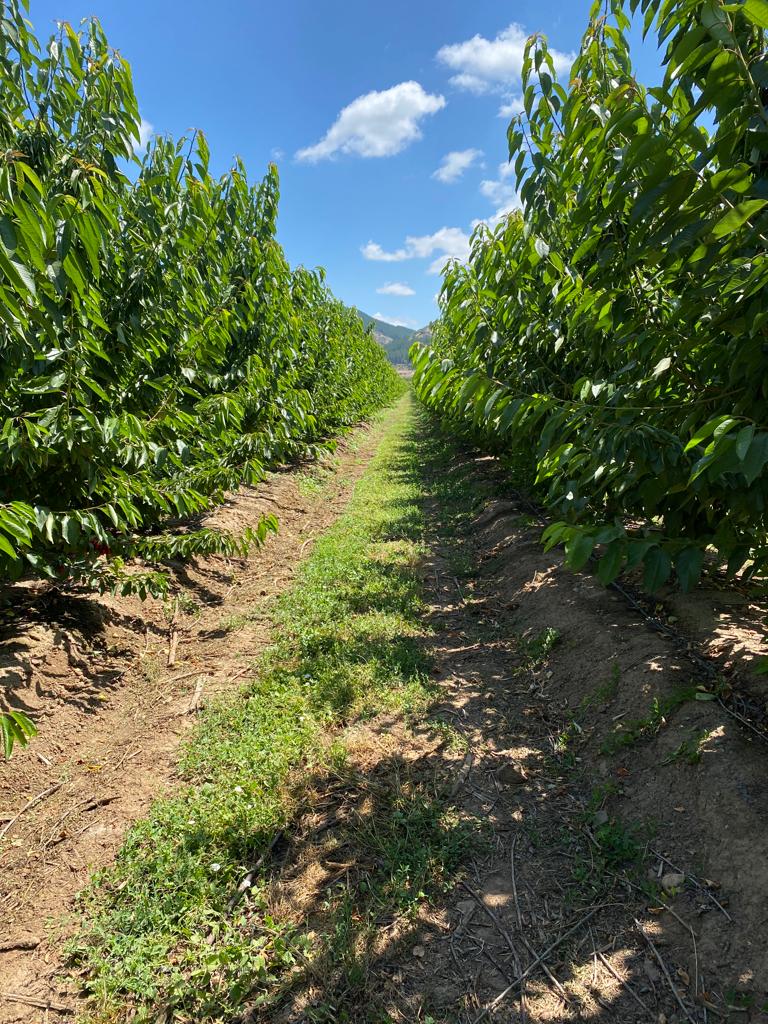Según los especialistas el fenómeno de La Niña se establecerá a fines de agosto y con ello existirá un notoria baja pluviométrica, alta radiación, pero a la vez, heladas primaverales; esto, sin duda, será uno de los grandes dolores de cabeza de la temporada de cerezas 2024-2025.
There are several definitions for the term frost, one of them established by INIA in its document “Frosts. Factors, trends and effects on fruit trees and vines”: “Frost is considered meteorological when the air temperature at 1.50 m from the ground drops to a value equal to or lower than the freezing point of water, that is, 0 °C, regardless of its duration or intensity. From an agrometeorological point of view, frost could be defined as the temperature at which plant tissues begin to suffer damage.” The lower the temperatures and the longer the frost lasts, the greater the damage to plants can be.
Types of frost
There are different types of frost, which can be classified according to synoptic origin, time of occurrence, and visual appearance.
- According to synoptic origin:
Advective frost: They usually occur after a frontal system, when a mass of cold air with high pressures enters from polar areas; that is, they are produced due to the movement of a mass of cold air over a specific region. Their main characteristics include: clear skies, variable winds, frost in large areas and persistent days.
Radiative frost: They occur during clear nights and are caused by the loss of radiation from the surface during a clear night and dry atmosphere. Their characteristics include: heat loss, night cooling, clear skies, weak wind, local frost.
Mixed Frost: Combination of advection and radiation frosts; rather than being a type of frost, it is a transition between the cold air mass and the loss of heat from the ground through radiation.
Evaporation frost: They are produced due to the evaporation of water from the surface of plants. They usually occur when the relative atmospheric humidity decreases and the dew formed on the plants evaporates, a process that requires heat; this is provided by the plant, generating a subsequent cooling of the same.
2. According to time of occurrence:
Spring or late frosts: They are recorded once winter is over and mainly affect annual cycle crops and fruit trees in their reproductive process.
Autumn or early frosts: Episodes prior to the arrival of winter and can be harmful to crops that are in the harvest period.
Winter frosts: They are generated when there is a significant decrease in temperature. They can affect all types of crops, however they are not harmful to deciduous fruit trees because they are in a dormant period.
3. According to visual aspect:
Black Frost: There is no frost and the affected plants turn black the day after the phenomenon; the damaged parts of the plants die. They occur when there is a low concentration of water vapor in the atmosphere, which in turn causes lethal temperatures for crops. This is the type of frost that can cause the most damage to agriculture.
White frost or hoarfrost: A less severe climatic phenomenon than black frost. In simple terms, it is the freezing of dew, which occurs when the surface of bodies reaches a temperature below or equal to 0° C.
It's time to control
Although in our territory, and specifically in the areas where there are cherry orchards, which goes from Ovalle in the north to Chile Chico in the south, there are different phenological states, it is time to be prepared for frost control. In the northern part of the country there are plots that began flowering three weeks ago, while in the central area there are signs of green tips, swollen buds and some flowering in earlier varieties.
It should be noted that the greatest damage from cold occurs in early phenological stages, rather than in late ones; between the stages of swollen bud and exposed bouquet is where there is greater sensitivity to frost.
Fortunately, there are a number of methods for controlling frost; below are some of them, with their advantages and disadvantages. It is worth remembering that each case, depending on the variety, geographical area, climate, etc., is particular, and therefore there are methods more suitable than others for specific cases, when it comes to controlling frost.
1. Sprinkler Irrigation Systems
- Working Principle: Sprinkler irrigation is used to form a layer of ice on trees, which can protect flowers and fruits by releasing heat during the freezing process.
- Advantages: Effective in areas with good water supply. Also helps maintain temperature in the flower area.
- Disadvantages: Requires a constant supply of water and a well-designed sprinkler system.
2. Drip Irrigation
- Working Principle: Similar to sprinkler irrigation, but used primarily to keep the soil moist rather than forming a layer of ice.
- Advantages: Lower water consumption compared to sprinkler irrigation. Ideal for situations where water is limited.
- Disadvantages: Less effective at creating a protective ice layer.
3. Thermal Covers
- Working Principle: Use special covers or blankets to cover cherry trees at night to reduce exposure to cold.
- Advantages: Provides a physical barrier against the cold and can be effective in areas with occasional frost.
- Disadvantages: Depending on the system, it requires labor to place and remove the covers.
4. Heating Systems
- Working Principle: Heat sources, such as heaters or radiant heat systems, are used to raise the temperature around the cherry trees.
- Advantages: Can be very effective if used correctly.
- Disadvantages: Expensive and can require a lot of energy, as well as being less efficient in very large areas.
5. Air Fans
- Working Principle: Fans are used to move cold air upward and mix it with warmer air closer to the ground.
- Advantages: Can be effective in preventing ice formation if used in combination with other methods.
- Disadvantages: Requires power and may not be sufficient on its own in extreme conditions.
6. Propane Burners
- Working Principle: Burners disperse heat into the air to raise the temperature around the cherry trees.
- Advantages: Provides direct heat and is relatively easy to use on small fields.
- Disadvantages: Expensive in terms of fuel consumption and less effective in large areas.
7. Monitoring and Alert Systems
- Operating Principle: These systems include sensors and weather stations to monitor weather conditions and issue alerts about the risk of frost.
- Advantages: Allows for rapid response and advance planning.
- Disadvantages: May require initial investment in technology and maintenance.
8. Soil Management and Cultivation Technique
- Operating Principle: Improve soil drainage and use cultivation techniques such as mulching to moderate soil temperature. It is also recommended to keep the soil as free of weeds as possible, which helps it accumulate more radiation during the day and release it at night.
- Advantages: Can complement other protection methods.
- Disadvantages: Less effective as the only method of protection.
Each method has its own advantages and disadvantages, and choosing the right system will depend on factors such as crop size, local climate, resource availability and budget. In many cases, a combination of these methods can provide the best protection against frost.








